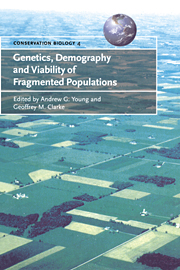Book contents
- Frontmatter
- Contents
- List of contributors
- Foreword by Peter F. Brussard
- Preface
- 1 Introduction: genetics, demography and the conservation of fragmented populations
- Part I Introductory concepts
- Part II Animal case studies
- Part III Plant case studies
- 14 Limited forest fragmentation improves reproduction in the declining New Zealand mistletoe Peraxilla tetrapetala (Loranthaceae)
- 15 Ecology and genetics of Grevillea (Proteaceae): implications for conservation of fragmented populations
- 16 Genetic and demographic influences on population persistence: gene flow and genetic rescue in Silene alba
- 17 Fragmentation in Central American dry forests: genetic impacts on Swietenia humilis (Meliaceae)
- 18 Population viability analysis of the rare Gentiana pneumonanthe: the importance of genetics, demography and reproductive biology
- 19 Genetic erosion, restricted mating and reduced viability in fragmented populations of the endangered grassland herb Rutidosis leptorrhynchoides
- 20 Conclusions and future directions: what do we know about the genetic and demographic effects of habitat fragmentation and where do we go from here?
- References
- Index
18 - Population viability analysis of the rare Gentiana pneumonanthe: the importance of genetics, demography and reproductive biology
Published online by Cambridge University Press: 29 January 2010
- Frontmatter
- Contents
- List of contributors
- Foreword by Peter F. Brussard
- Preface
- 1 Introduction: genetics, demography and the conservation of fragmented populations
- Part I Introductory concepts
- Part II Animal case studies
- Part III Plant case studies
- 14 Limited forest fragmentation improves reproduction in the declining New Zealand mistletoe Peraxilla tetrapetala (Loranthaceae)
- 15 Ecology and genetics of Grevillea (Proteaceae): implications for conservation of fragmented populations
- 16 Genetic and demographic influences on population persistence: gene flow and genetic rescue in Silene alba
- 17 Fragmentation in Central American dry forests: genetic impacts on Swietenia humilis (Meliaceae)
- 18 Population viability analysis of the rare Gentiana pneumonanthe: the importance of genetics, demography and reproductive biology
- 19 Genetic erosion, restricted mating and reduced viability in fragmented populations of the endangered grassland herb Rutidosis leptorrhynchoides
- 20 Conclusions and future directions: what do we know about the genetic and demographic effects of habitat fragmentation and where do we go from here?
- References
- Index
Summary
ABSTRACT
The relative importance of demography, genetics and reproductive biology for the viability of small populations was assessed forthe rare perennial herb Gentiana pneumonanthe. Based on a previously published analysis, a stochastic matrix projection model was constructed to simulate population dynamics during heathland succession after management-induced disturbance (sod-cutting). Demographic data were used mainly from one population that has been censused from the invasive to the regressive stage of population succession. In earlier studies, I established the relationships between population size, selfing rate and inbreeding depression, as well as between population size and reproductive success. Three variants of the basic, demographic model were made, incorporating (1) the relationship between population size and reproductive success (RE variant), (2) the relationships between population size, selfing rate and inbreeding depression (ID variant) and (3) both of the above relationships (RE + ID variant). Reduced reproductive success did not have a significant effect on population performance. Inbreeding depression, however, resulted in significantly lower peak population sizes, a more rapid extinction and a lower growth rate. The latter effects were even stronger in the RE + ID model. In this variant, the time to extinction, TE, of small populations decreased by six years relative to the basic model. Significant differences in TE between the basic model and this variant persisted up to an initial population size of 250 plants. Further simulations with various time intervals between sod-cutting again showed that the RE variant differed very little from the basic model. The ID variant differed only for initial population sizes of <50 individuals.
- Type
- Chapter
- Information
- Genetics, Demography and Viability of Fragmented Populations , pp. 313 - 334Publisher: Cambridge University PressPrint publication year: 2000
- 40
- Cited by

